
| Size | Price | Stock | Qty |
|---|---|---|---|
| 5mg |
|
||
| 10mg |
|
||
| 25mg |
|
||
| 50mg |
|
||
| 100mg |
|
||
| 250mg |
|
||
| 500mg |
|
||
| Other Sizes |
Purity: ≥98%
AS-252424 is a novel, potent, orally bioactive and selective PI3Kγ inhibitor with potential anticancer activity. With an IC50 of 30 nM in a cell-free assay, it inhibits PI3Kγ with little to no inhibitory activity against PI3Kδ/β and exhibits a 30-fold preference for PI3Kγ over PI3Kα. In particular, AS52424 reduced cell proliferation in the pancreatic cancer cell lines Capan 1 and HPAF.
| Targets |
PI3Kα (IC50 = 935 nM); PI3Kγ (IC50 = 30 nM); PI3Kδ (IC50 = 20 μM); PI3Kβ (IC50 = 20 μM)
|
|---|---|
| ln Vitro |
AS-252424 is a furan-2-ylmethylene thiazolidinedione as a selective ATP-competitive PI3Kγ inhibitor with IC50 with 33 nM. With an IC50 of 935 nM, AS-252424 demonstrates decreased potency on PI3K. As of 10 μM, AS-252424 exhibits no significant inhibitory activity against any of the 80 different Ser/Thr and Tyr kinases tested, with the exception of CK2. AS-252424 has a concentration-dependent, submicromolar or low-micromolar IC50 value that inhibits C5a-mediated PKB/Akt phosphorylation. AS-252424 has an IC50 value of 52 μM in wild-type primary monocytes and an IC50 value of 53 M in the monocytic cell line THP-1, both of which are chemotactically inhibited by MCP-1 in a concentration-dependent manner.[1] AS252424 specifically blocks proliferation in the pancreatic cancer cell lines HPAF and Capan1, as assessed by cell counting. [2] According to a recent study, AS-252424 at 100 nM significantly lowers [Ca2+]i, ICa, and Ca2+ transients in HL-1 cardiomyocytes.[3]
|
| ln Vivo |
A moderate reduction in neutrophil recruitment (35%), caused by oral administration of AS-252424 at 10 mg/kg, is almost identical to the result seen in PI3K-deficient mice. [1]
|
| Enzyme Assay |
Human PI3Kγ (100 ng) is incubated at RT with kinase buffer (10 mM MgCl2, 1 mM β-glycerophosphate, 1 mM DTT, 0.1 mM Na3VO4, 0.1% Na Cholate and 15 M ATP/100 nCi γ[33]ATP, final concentrations) and lipid vesicles containing 18 M PtdIns and 250 M of PtdSer (final concentrations), in the presence of AS-252424 or DMSO. By first adding 250 g of Neomycin-coated Scintillation Proximity Assay (SPA) beads, the kinase reaction is stopped.
|
| Cell Assay |
Raw-264 macrophages are pretreated for 30 minutes with AS-252424 or DMSO after being starved for three hours in serum-free medium, and then stimulated for five minutes with 50 nM C5a. Phospho-Ser-473 Akt specific antibody and common ELISA procedures are used to monitor PKB/Akt phosphorylation.
|
| Animal Protocol |
Mice[1]:
PI3K knockout (KO) mice are the animals used in this study. PI3K-deficient mice are administered AS-252424 orally at a dose of 10 mg/kg.
|
| References |
| Molecular Formula |
C14H8NO4FS
|
|---|---|
| Molecular Weight |
305.28102
|
| Exact Mass |
305.015
|
| Elemental Analysis |
C, 55.08; H, 2.64; F, 6.22; N, 4.59; O, 20.96; S, 10.50
|
| CAS # |
900515-16-4
|
| Related CAS # |
900515-16-4
|
| PubChem CID |
11630874
|
| Appearance |
Light yellow to yellow solid powder
|
| Density |
1.6±0.1 g/cm3
|
| Index of Refraction |
1.692
|
| LogP |
2.14
|
| Hydrogen Bond Donor Count |
2
|
| Hydrogen Bond Acceptor Count |
6
|
| Rotatable Bond Count |
2
|
| Heavy Atom Count |
21
|
| Complexity |
484
|
| Defined Atom Stereocenter Count |
0
|
| SMILES |
OC1C=C(F)C=CC=1C1=CC=C(/C=C2/C(=O)NC(=O)S/2)O1
|
| InChi Key |
OYYVWNDMOQPMGE-SDQBBNPISA-N
|
| InChi Code |
InChI=1S/C14H8FNO4S/c15-7-1-3-9(10(17)5-7)11-4-2-8(20-11)6-12-13(18)16-14(19)21-12/h1-6,17H,(H,16,18,19)/b12-6-
|
| Chemical Name |
(5Z)-5-[[5-(4-fluoro-2-hydroxyphenyl)furan-2-yl]methylidene]-1,3-thiazolidine-2,4-dione
|
| Synonyms |
AS252424; AS 252424; AS-252424
|
| HS Tariff Code |
2934.99.9001
|
| Storage |
Powder -20°C 3 years 4°C 2 years In solvent -80°C 6 months -20°C 1 month |
| Shipping Condition |
Room temperature (This product is stable at ambient temperature for a few days during ordinary shipping and time spent in Customs)
|
| Solubility (In Vitro) |
DMSO: ~61 mg/mL (~199.8 mM)
Water: <1 mg/mL Ethanol: <1 mg/mL |
|---|---|
| Solubility (In Vivo) |
4%DMSO+50%PEG 300+5%Tween 80+ddH2O: 5mg/mL (Please use freshly prepared in vivo formulations for optimal results.)
|
| Preparing Stock Solutions | 1 mg | 5 mg | 10 mg | |
| 1 mM | 3.2757 mL | 16.3784 mL | 32.7568 mL | |
| 5 mM | 0.6551 mL | 3.2757 mL | 6.5514 mL | |
| 10 mM | 0.3276 mL | 1.6378 mL | 3.2757 mL |
*Note: Please select an appropriate solvent for the preparation of stock solution based on your experiment needs. For most products, DMSO can be used for preparing stock solutions (e.g. 5 mM, 10 mM, or 20 mM concentration); some products with high aqueous solubility may be dissolved in water directly. Solubility information is available at the above Solubility Data section. Once the stock solution is prepared, aliquot it to routine usage volumes and store at -20°C or -80°C. Avoid repeated freeze and thaw cycles.
Calculation results
Working concentration: mg/mL;
Method for preparing DMSO stock solution: mg drug pre-dissolved in μL DMSO (stock solution concentration mg/mL). Please contact us first if the concentration exceeds the DMSO solubility of the batch of drug.
Method for preparing in vivo formulation::Take μL DMSO stock solution, next add μL PEG300, mix and clarify, next addμL Tween 80, mix and clarify, next add μL ddH2O,mix and clarify.
(1) Please be sure that the solution is clear before the addition of next solvent. Dissolution methods like vortex, ultrasound or warming and heat may be used to aid dissolving.
(2) Be sure to add the solvent(s) in order.
|
 |